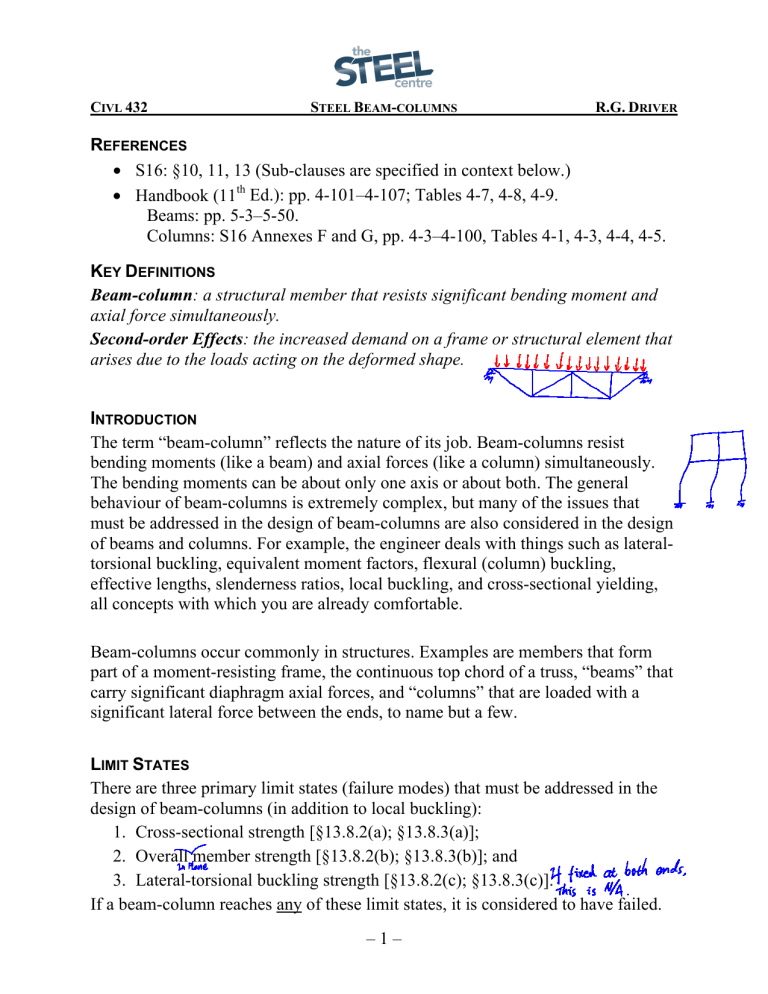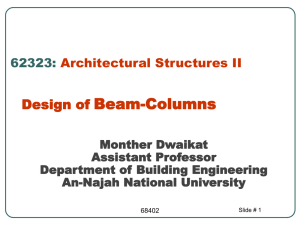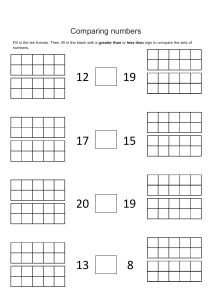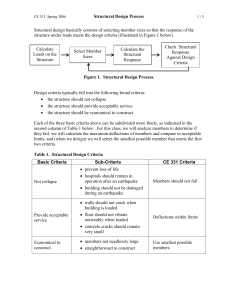
CIVL 432 STEEL BEAM-COLUMNS R.G. DRIVER REFERENCES S16: §10, 11, 13 (Sub-clauses are specified in context below.) Handbook (11th Ed.): pp. 4-101–4-107; Tables 4-7, 4-8, 4-9. Beams: pp. 5-3–5-50. Columns: S16 Annexes F and G, pp. 4-3–4-100, Tables 4-1, 4-3, 4-4, 4-5. KEY DEFINITIONS Beam-column: a structural member that resists significant bending moment and axial force simultaneously. Second-order Effects: the increased demand on a frame or structural element that arises due to the loads acting on the deformed shape. INTRODUCTION The term “beam-column” reflects the nature of its job. Beam-columns resist bending moments (like a beam) and axial forces (like a column) simultaneously. The bending moments can be about only one axis or about both. The general behaviour of beam-columns is extremely complex, but many of the issues that must be addressed in the design of beam-columns are also considered in the design of beams and columns. For example, the engineer deals with things such as lateraltorsional buckling, equivalent moment factors, flexural (column) buckling, effective lengths, slenderness ratios, local buckling, and cross-sectional yielding, all concepts with which you are already comfortable. Beam-columns occur commonly in structures. Examples are members that form part of a moment-resisting frame, the continuous top chord of a truss, “beams” that carry significant diaphragm axial forces, and “columns” that are loaded with a significant lateral force between the ends, to name but a few. LIMIT STATES There are three primary limit states (failure modes) that must be addressed in the design of beam-columns (in addition to local buckling): 1. Cross-sectional strength [§13.8.2(a); §13.8.3(a)]; 2. Overall member strength [§13.8.2(b); §13.8.3(b)]; and 3. Lateral-torsional buckling strength [§13.8.2(c); §13.8.3(c)]. If a beam-column reaches any of these limit states, it is considered to have failed. –1– CIVL 432 STEEL BEAM-COLUMNS R.G. DRIVER SECOND-ORDER EFFECTS P- Effect The term “P- effect” refers to the amplification of bending moments that arises due to an axial force acting on a member that is deformed laterally between its ends. This effect is seldom accounted for in structural analysis (including in computer-aided analysis), so it must be included in the design equation itself, as will be seen later. Consider the following beam-column loaded with an axial force, C, and with equal and opposite end moments, M0 , about one axis. Figure (a) shows both the actual beam-column and a schematic representation of the beam-column deformed under the applied loads, where v is the lateral deflection of the member that varies along its length and is the maximum deflection, in this case at mid-height due to symmetry. Figure (b) is the bending moment diagram of the primary moment (or first-order moment), i.e., the moment distribution that is deduced from the undeformed member. In this case, the primary moments are those that develop from the application of the two concentrated end moments that result in a constant bending moment along the length. (The primary moment in a beam-column could also develop from the application of a transverse load between the ends.) Figure (c) is the bending moment diagram of the secondary moment, i.e., the moment distribution deduced from the axial force acting on the deformed member that varies with the value of the deflection, v. This moment is the result of the so-called P- effect and it can be quite significant. The –2– CIVL 432 STEEL BEAM-COLUMNS total moment, or second-order moment, at any point on the beam-column is simply the sum of the primary and secondary moments at that point. It can easily be shown (see, for example, Kulak and Grondin (2010)) that for a sinusoidal deformed shape, the secondorder deflection, , can be calculated from the primary deflection, I , as follows: [1] C I 1 Ce 1 R.G. DRIVER Trap Don’t confuse the secondary moment with the second-order moment. The former is the moment due to the axial force alone and the latter is the total of the primary and secondary moments. However, the primary and first-order moments are the same. (All these terms are also used with the deflection and they have an analogous meaning.) where Ce is the Euler buckling capacity of the member loaded as a column. The term in brackets in Equation [1] is often referred to as the amplification factor, since it indicates how much the P- effect amplifies the primary deflection. Clearly, if the axial load approaches the column buckling load, the amplification is large. A similar equation can be derived for the amplification of the moment. The deformed shape is not necessarily sinusoidal, but rather is dependent on the moment distribution itself. This introduces painful complexities in the rigorous formulation, which is impractical for use in design. Instead, a simple approximate factor is used for the amplification of the maximum primary moment, MI,max , to account for the P- effect: [2] M max C M I ,max 1 1 Ce 1 where 1 is an equivalent moment factor Trap (analogous to 2 used for laterally unsupported beams) that accounts for the distribution of the The parameter 2 was formulated primary moments. This parameter is 1.0 for the worst case of a uniform moment and reduces the to increase the LTB capacity. The parameter 1 decreases the moment for any more favourable distribution. applied factored moment instead. Since the term in brackets in Equation [2] The two effects are similar. increases the moment, the net result is that the primary moment, MI,max , could either be increased or decreased depending on the relative magnitudes of the competing factors. So keep in mind that Equation [2] really accounts for the P- effect in the presence of a moment gradient. (The way 1 is formulated in S16 will be discussed later, along with the design equation.) –3– CIVL 432 STEEL BEAM-COLUMNS R.G. DRIVER P- Effect The term “P- effect” refers to the amplification of bending moments that arises due to an axial force acting on a member with one end translated with respect to the other (as in a column of a laterally loaded moment-resisting frame). Since this phenomenon is generally considered in the determination of the design moments and forces themselves, and is most often accounted for during the structural analysis, it is discussed in the course notes on Steel Frames. CROSS-SECTIONAL STRENGTH CONCEPTS As indicated previously, the design of a beam-column must address three primary limit states. However, S16 makes use of a single equation for all three, the difference being in how the various constituent parameters of the equation are defined. The design equation is formulated in terms of a strength ratio, based on an approximate representation of the cross-sectional strength limit state. The term “strength ratio” implies that the ratios of the factored load effects to their respective factored capacities are summed, and the result is then compared to 1.0. Exceeding 1.0 implies failure of the member. This approach is very common for cases where two or more things are going on at once in a structural member (in this case it’s (1) axial compression, and either one or both of (2) bending about the strong axis and (3) bending about the weak axis). Just like a laterally supported beam, a beam-column can fail by full yielding of the cross-section (if Class 1 or Class 2). Figure (a) below shows a beam-column that is loaded in compression as well as in bending about the strong axis. Figures (b) through (d) show strain and stress diagrams at various stages of loading. The main difference among these figures—and the ones shown previously for beams—is that the neutral axis is shifted due to the presence of compression. –4– CIVL 432 STEEL BEAM-COLUMNS R.G. DRIVER If, for expediency, we assign the symbol Mpc to the plastic moment capacity in the presence of a compressive force, C, then we can write an interaction equation for strong-axis bending as follows: [3] C 1.181 C Mp y M pc where Cy is the total cross-sectional capacity under axial compression only. Similarly, we can write an equation for weak-axis bending in the presence of a compressive force: [4] C 1.671 C Mp y M pc Where do these come from you ask? Although the exact equations for I-shaped sections are actually dependent upon the various cross-sectional dimensions, the range of available wide-flange shapes conveniently forms relatively narrow bands on the interaction diagrams. The following graphs show how these two equations measure up, where Af is the flange area and Aw is the web area. Although the fit of the two “linearised” equations is quite good, particularly for the strong axis, the fact that the equations do not predict a compressive capacity of zero when the full plastic moment is applied reveals the need for a “cut-off” so that the moment will never exceed Mp . Rearranging Equations [3] and [4] and adding the cut-off, we get for compression with strong- and weak-axis bending, respectively: –5– CIVL 432 [5] STEEL BEAM-COLUMNS R.G. DRIVER M pc C 0.85M pc 1.0 and 1.0 Cy Mp Mp and [6] M pc C 0.6M pc 1.0 and 1.0 Cy Mp Mp DESIGN Equations [5] and [6] form the basis of the single equation in S16 that is used for all three limit states for design. In addition to changing the notation to that which is consistent with the standard, the P- effect and equivalent moment factors (see Equation [2]) must be added since they were not part of the formulation based solely on cross-sectional strength. Moreover, it has been found that the factor 0.6 in the The variable weak axis equation (Equation [6]) does not give good results accounts more when the moment is high and the beam-column is slender, and accurately for the it has therefore been replaced by a variable, , described below. effect of distributed plasticity on weak axis stability. One last explanation is required before the equation can be presented, along with explanations of its plethora of component factors. An important distinction is made in S16 [§13.8.1] between braced and unbraced frames. In essence, if the beam-column is part of a frame that incorporates stiff “direct-acting” bracing such as cross-bracing, the member is considered to be part of a braced frame. Conversely, if the beam-column is part of a frame without direct-acting bracing (or with flexible braces of some kind), the member is considered to be part of an unbraced frame. Details about how to evaluate whether direct-acting bracing is “stiff” or “flexible” will be presented in the course notes on Steel Frames. Technical Stuff The beam-column design interaction equation for Class 1 and 2 I-shaped members is: [7] M fx M fy Cf 0.85U1x M fx U1y M fy 1.0 1.0 and M rx M ry Cr M rx M ry [§13.8.2] where the subscripts x and y indicate the “strong” and “weak” axis cases, respectively, Cf and Mf are the factored compressive force and the maximum factored moment (including P- effects), respectively, in the beam-column, and: 0.6 0.4 y 0.85 [§13.8.2] [8] where y is the weak-axis slenderness ratio (same as the one used for columns). –6– CIVL 432 STEEL BEAM-COLUMNS R.G. DRIVER Tip The ratio obtained from Equation [7] or [14] (that is compared to 1.0) is sometimes referred to as the efficiency ratio because the closer it is to 1.0 (but still less than or equal to 1.0), the more efficiently the material is being used. However, keep in mind that the efficiency ratio could be much less than 1.0 if considerations other than strength (e.g., deflection) govern the design. Since the definitions of the other parameters vary depending on the limit state being checked, they will be defined in the following sub-sections. Limit State 1—Cross-sectional Strength This limit state only needs to be checked for members in braced frames simply because for unbraced frames it can never govern. The various as-yet-undefined parameters in Equation [7] are defined as follows: Cr is as defined in §13.3 with = 0; Tip Mr is as defined in §13.5; Not surprisingly, the design equation U1 is as defined in §13.8.4 (explained for beam-columns makes use of the below), but not less than 1.0; and equations for beams and columns. It y is taken as 0 in the calculation of . would be too cumbersome to repeat everything here, so be alert to the Limit State 2—Overall Member Strength fact that you will need to keep these previous notes close at hand. For This limit state addresses the in-plane (i.e., no LTB) behaviour of the member as a whole, example, for the equation for y , see §13.3.1 and take the slenderness accounting for the P- effect. It is analogous ratio for the weak axis. to flexural buckling of a column, but in the presence of bending moments. The parameters Tip in Equation [7] that were defined in the previous section are re-defined for this limit state as follows: Although not stated Cr is as defined in §13.3 (i.e., use Cr,min), except explicitly in S16, I suggest that for uniaxial bending cases, the axial capacity you use the same K for y related to buckling about the bending axis is used (in the calculation of ) as (even if it does not give the lower capacity!). Use for Cry (i.e., K = 1.0 for K = 1.0 [§10.3.2]; Limit State 2). Mr is as defined in §13.5; U1 is as defined in §13.8.4 for members in braced frames; and U1 = 1.0 for members in unbraced frames. –7– CIVL 432 STEEL BEAM-COLUMNS R.G. DRIVER Limit State 3—Lateral–Torsional Buckling Strength Of course, this limit state need not be checked if bracing is provided that would prevent LTB. Also, LTB cannot occur if bending is induced about the weak axis only. The parameters in Equation [7] are re-defined yet again for this limit state as follows: Cr is as defined in §13.3 and is based on weak-axis buckling using the actual weak axis effective length ( 1.0) [§10.3.3], although it is common to use K = 1.0 for simplicity and conservatism; Mrx is as defined in §13.6; Mry is as defined in §13.5; U1x is as defined in §13.8.4, but not less than 1.0, for members in braced frames; U1y is as defined in §13.8.4 for members in braced frames; and U1 = 1.0 for members in unbraced frames. P- Effect and Equivalent Moment Factor Equation [2] hinted at the treatment of the P- effect and equivalent moment factor for beam-columns. S16 assigns the symbol U1 to the combined effect of these two phenomena as follows: [9] C U1 1 1 f Ce 1 [§13.8.4] where: [10] Ce 2 EI L2 [§13.8.4] and for members not subjected to transverse loads between the supports: 1 0.6 0.4 0.4 [11] [§13.8.5(a)] where is the ratio of the smaller to the larger factored moment at opposite ends of the beam-column, positive for double curvature and negative for single curvature. For members subjected to distributed loads or a series of closely-spaced point loads between supports: 1 1.0 [12] [§13.8.5(b)] For members subjected to a concentrated load or moment between supports: 1 0.85 [§13.8.5(c)] [13] –8– CIVL 432 STEEL BEAM-COLUMNS R.G. DRIVER A few words of explanation are required about Equation [10]: The parameter Ce is the Euler buckling load, with an effective length factor of 1.0, for the axis about which U1 is being evaluated (again, it doesn’t have to be the lower of the two capacities). The ratio in the term in brackets in Equation [9], therefore, represents how close the member would be to buckling about the axis of bending if the axial force were to act alone. The closer this ratio is to 1.0, the more severe the P- effect and the greater the value of U1 . Sections Other Than Class 1 and 2 I-shaped Members Although Equation [7] applies only to Class 1 and 2 I-shaped members, these are the ones most commonly used as beam-columns. Nevertheless, S16 also addresses other cases (Class 3 or other shapes) with a similarly structured equation: [14] Cf U1x M fx U1y M fy M fx M fy 1.0 and 1.0 Cr M rx M ry M rx M ry [§13.8.3] Note that the 0.85 and factors have disappeared (they were related to reaching the plastic moment, which Class 3 members cannot do!). All the other parameters for the three limit states are defined in the same way as previously described, but it must be kept in mind that the strengths are calculated based on the appropriate class of cross-section. Local Buckling Local buckling was covered for beams in CIVL 331. The means of determining the class of an I-shaped beam-column section is identical, except for the fact that the combination of compression and flexure creates a more severe situation for the web than pure flexure. Consequently, the limiting width-to-thickness ratios for webs (i.e., h/w) are a function of the factored axial force, Cf (see S16 Table 2 in the CIVL 331 review notes). DISCUSSION Beam-column behaviour is complex; there’s no way around it. To truly understand the subtleties of the behaviour requires an advanced knowledge of structural engineering and mechanics. The fact that it is so complex necessitates many simplifying assumptions that, unintentionally (and unfortunately), tend to mask the transparency of the origins of the design equations. Nevertheless, a graduate of CIVL 432 is able to design beam-columns competently for common cases. The following is a list of miscellaneous points that may (or may not!) help you to understand beam-column behaviour better and, in particular, help you to understand why the parameters in Equation [7] are defined the way they are. (Lots of explanation is required for U1 .) –9– CIVL 432 STEEL BEAM-COLUMNS R.G. DRIVER Although we think of U1 as accounting for the P- effect and thus amplifying the applied moment, in some cases it can actually be less than 1.0. This can occur if the beneficial effect of the moment gradient (1 ≤ 1.0) overpowers the amplification, resulting in U1 < 1.0. Although it is tempting based on the equation for U1 to separate the P- amplifier and the equivalent moment factor into two distinct and independent components, in reality the equation represents a single factor that accounts for the P- effect in the presence of a moment gradient. Note that U1 always equals 1.0 for unbraced frames. This leads to the conclusion that the cross-sectional strength check cannot govern for unbraced frames. Tip See me if you don’t get this. The reason that U1 = 1.0 for unbraced frames is that in a sway frame the maximum moments typically occur at the ends of the member, whereas the amplification from the P- effect, by definition, occurs between the ends. The net result is that although the P- effect is very much present—just like in braced frames—it is not the maximum (design) moment that is amplified. The figures on the right demonstrate this pictorially. The value of U1 for the cross-sectional strength check cannot be less than 1.0 because the moment distribution along the length should have no effect on the crosssectional demand. Therefore, we cannot justify reducing the design moment. (Note that if U1 were an exact representation of the P- effect, this special restriction would be accounted for automatically.) In the lateral-torsional buckling strength check, U1x for braced frames also cannot be less than 1.0, but for a very different reason. This is the only case where “2” creeps into the picture by way of the LTB equation for beams. – 10 – CIVL 432 STEEL BEAM-COLUMNS R.G. DRIVER To make a very long story sort-of short, 2 increases the flexural capacity in the presence of a moment gradient and 1 decreases the applied factored moment in the presence of the same moment gradient. In effect, the moment gradient appears to have been accounted for twice, potentially resulting in a non-conservative outcome. This eventually became known as the “double ” issue, which attracted lots of discussion in the technical community. Without going into the debate in detail, there are arguments that keeping the double is actually rational (i.e., the “true” capacity assessed against the “true” demand); however, it does not seem reasonable under these circumstances to permit the primary applied moment to be reduced. To address the problem in a simple way, U1x is limited to being not less than 1.0. (Note that the double issue arises only for the LTB limit state for strong-axis bending in braced frames.) For the overall member strength check, the effective length factor, K, for determining Cr is set equal to 1.0 because for braced frames, it provides an upper bound (conservative) solution for the elastic case and is typically reasonable after some distributed plasticity is present. (Note that the “traditional” K-values are based on elastic behaviour.) In the case of unbraced frames, in the “old days” designers selected effective length factors greater than 1.0 to account for sway. This is now considered to be a questionable practice (in terms of accuracy) and is no longer permitted in Canada. This is why the value of K for unbraced frames is also set to 1.0. Although this practice might appear on the surface to be non-conservative, the sway (and resulting P-) effect is actually accounted for directly in the analysis when determining the factored internal forces and moments themselves through a second-order analysis. This is discussed further in the course notes on Steel Frames. – 11 – CIVL 432 STEEL BEAM-COLUMNS R.G. DRIVER SUMMARY OF IMPORTANT CONCEPTS Beam-columns share features of both beams and columns. The design equation in S16—although it might appear complex—is actually a highly simplified representation of actual behaviour. There are three limit states that must be checked when designing a beam-column: (1) cross-sectional strength; (2) overall (in-plane) member strength; and (3) lateral-torsional buckling strength. The beam-column clauses in S16 make an important distinction between braced and unbraced frames. (Further discussion can be found in the course notes on Steel Frames.) Second-order effects, consisting of P- and P- effects, can be highly influential on the behaviour and design of beam-columns. P- effects are the amplification of bending moments due to an axial force acting on a member that is deformed laterally between its ends. P- effects are the amplification of bending moments due to an axial force acting on a member with one end translated with respect to the other. If you want to keep out of trouble, great care is required in applying the beam-column interaction equation in order to account for: (a) class of cross-section; (b) braced or unbraced frame; (c) correct axis of bending (note subscripts); (d) proper strength equations for beams and columns; (e) proper effective length factor, K; and (f) special restrictions on U1 . Credits: The figures used in this document are © Kulak, G.L. and Grondin, G.Y. (2002) Limit States Design in Structural Steel, Canadian Institute of Steel Construction, Toronto, ON, © Handbook of Steel Construction (2000), Canadian Institute of Steel Construction, Toronto, ON, or Segui, W.T. (1999) LRFD Steel Design, Brooks/Cole Publishing Co., Pacific Grove, CA. steelcentre.ca – 12 –




